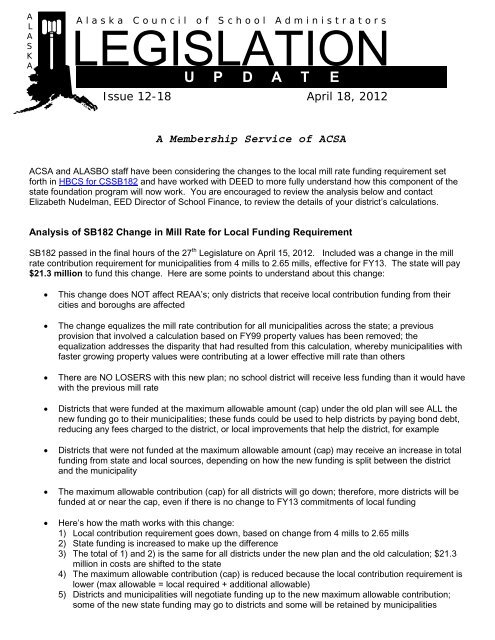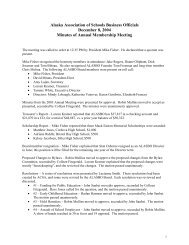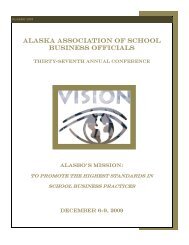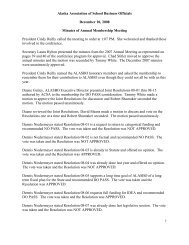ACSA â Legislative Newsletter - alaska association of school ...
ACSA â Legislative Newsletter - alaska association of school ...
ACSA â Legislative Newsletter - alaska association of school ...
You also want an ePaper? Increase the reach of your titles
YUMPU automatically turns print PDFs into web optimized ePapers that Google loves.
ALASKAA l a s k a C o u n c i l o f S c h o o l A d m i n i s t r a t o r sLEGISLATIONU P D A T EIssue 12-18 April 18, 2012A Membership Service <strong>of</strong> <strong>ACSA</strong><strong>ACSA</strong> and ALASBO staff have been considering the changes to the local mill rate funding requirement setforth in HBCS for CSSB182 and have worked with DEED to more fully understand how this component <strong>of</strong> thestate foundation program will now work. You are encouraged to review the analysis below and contactElizabeth Nudelman, EED Director <strong>of</strong> School Finance, to review the details <strong>of</strong> your district’s calculations.Analysis <strong>of</strong> SB182 Change in Mill Rate for Local Funding RequirementSB182 passed in the final hours <strong>of</strong> the 27 th Legislature on April 15, 2012. Included was a change in the millrate contribution requirement for municipalities from 4 mills to 2.65 mills, effective for FY13. The state will pay$21.3 million to fund this change. Here are some points to understand about this change:• This change does NOT affect REAA’s; only districts that receive local contribution funding from theircities and boroughs are affected• The change equalizes the mill rate contribution for all municipalities across the state; a previousprovision that involved a calculation based on FY99 property values has been removed; theequalization addresses the disparity that had resulted from this calculation, whereby municipalities withfaster growing property values were contributing at a lower effective mill rate than others• There are NO LOSERS with this new plan; no <strong>school</strong> district will receive less funding than it would havewith the previous mill rate• Districts that were funded at the maximum allowable amount (cap) under the old plan will see ALL thenew funding go to their municipalities; these funds could be used to help districts by paying bond debt,reducing any fees charged to the district, or local improvements that help the district, for example• Districts that were not funded at the maximum allowable amount (cap) may receive an increase in totalfunding from state and local sources, depending on how the new funding is split between the districtand the municipality• The maximum allowable contribution (cap) for all districts will go down; therefore, more districts will befunded at or near the cap, even if there is no change to FY13 commitments <strong>of</strong> local funding• Here’s how the math works with this change:1) Local contribution requirement goes down, based on change from 4 mills to 2.65 mills2) State funding is increased to make up the difference3) The total <strong>of</strong> 1) and 2) is the same for all districts under the new plan and the old calculation; $21.3million in costs are shifted to the state4) The maximum allowable contribution (cap) is reduced because the local contribution requirement islower (max allowable = local required + additional allowable)5) Districts and municipalities will negotiate funding up to the new maximum allowable contribution;some <strong>of</strong> the new state funding may go to districts and some will be retained by municipalities
• Watch out for:o Awareness <strong>of</strong> new maximum allowable local funding (cap); if a district budgets for funding thatexceeds the new cap, it will be informed by EED next fall that a refund is owed to themunicipality and the budget must be reduced!o Opportunity for additional funding from the municipality, up the amount <strong>of</strong> the new maximumallowable contribution• Note that if a municipality chooses to fund at the same level budgeting prior to this change, so long as itdoesn’t exceed the new maximum allowable amount, the district will receive an automatic increase infunding, because the district will be receiving more from the state• Note that municipalities will NOT be receiving checks from the state; this is a misstatement <strong>of</strong> how thefunding program works (the funds are not municipal revenue sharing); however, municipalities mayfund districts at a reduced amount, since the district is receiving more from the state and because theirlocal required funding amount has gone down• It is highly recommended that superintendents and <strong>school</strong> business <strong>of</strong>ficials take the time tounderstand this change, so that productive discussions with municipal <strong>of</strong>ficials can take place, and sothat no districts will be writing refund checks to their municipalities next fall!o Review EED’s “Public School Funding Program Overview” from September 2011• Note: The only updates to this document are the change in mill rate, and the change inthe voc ed factor, another component <strong>of</strong> SB182o Contact Elizabeth Nudelman, EED Director <strong>of</strong> School Finance, to review the specific figures foryour district: 907-465-8679, elizabeth.nudelman@<strong>alaska</strong>.gov2







